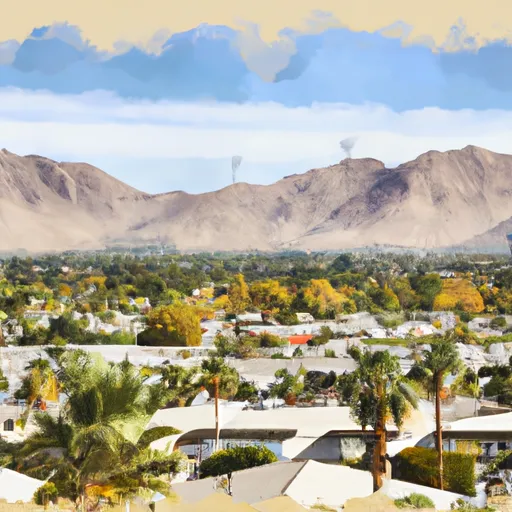-
 Snoflo Premium
Snoflo Premium
Get unlimited access to all our content
With no Ad interruptions! - Start Your Free Trial Login with existing account
La-Quinta
Eden Index
Climate
7.0
•
Recreation
4.6
•
Community
2.8
•
Safeguard
5.1/10

La Quinta, California, located in the Coachella Valley, offers a delightful year-round climate and numerous outdoor recreation opportunities. With its desert location, La Quinta experiences a hot and arid climate. Summers are scorching, with temperatures averaging around 100°F, while winters are mild, with highs around 70°F. The region receives minimal rainfall, with most occurring during the winter months.
La Quinta's hydrology constituents revolve around the Coachella Valley's underlying aquifer system. The valley is mostly dependent on groundwater, which is replenished by the surrounding mountains and rainfall. Additionally, the Coachella Canal, part of the Colorado River Aqueduct system, provides water for agricultural and domestic use.
The city boasts a variety of outdoor activities for nature enthusiasts. The Santa Rosa and San Jacinto Mountains National Monument offers opportunities for hiking, mountain biking, and wildlife viewing. Golf enthusiasts can enjoy numerous world-class golf courses, including the famous PGA West. La Quinta is also home to numerous parks, offering trails for walking, running, and picnicking. The nearby Lake Cahuilla Recreation Area provides fishing, camping, boating, and equestrian activities.
Overall, La Quinta's warm climate, hydrology constituents, and outdoor recreation opportunities make it an attractive destination for those seeking outdoor adventures in a beautiful desert setting.
What is the Eden Index?
The Snoflo Eden Index serves as a comprehensive rating system for regions, evaluating their desirability through a holistic assessment of climate health, outdoor recreation opportunities, and natural disaster risk, acknowledging the profound impact of these factors on livability and well-being.
Climate Health Indicator (CHI): 7.0
La-Quinta receives approximately
108mm of rain per year,
with humidity levels near 74%
and air temperatures averaging around
23°C.
La-Quinta has a plant hardyness factor of
9, meaning
plants and agriculture in this region tend to thrive here all year round.
By considering the ideal temperature range, reliable water supplies, clean air, and stable seasonal rain or snowpacks, the Climate Health Indicator (CHI) underscores the significance of a healthy climate as the foundation for quality living.
A healthy climate is paramount for ensuring a high quality of life and livability in a region, fostering both physical well-being and environmental harmony. This can be characterized by ideal temperatures, reliable access to water supplies, clean air, and consistent seasonal rain or snowpacks.
Weather Forecast
Streamflow Conditions
Salton Sea
Area Rivers
Salton Sea
Snowpack Depths
Salton Sea
Reservoir Storage Capacity
Salton Sea
Groundwater Levels
Recreational Opportunity Index (ROI): 4.6
The Recreational Opportunity Index (ROI) recognizes the value of outdoor recreational options, such as parks, hiking trails, camping sites, and fishing spots, while acknowledging that climate plays a pivotal role in ensuring the comfort and consistency of these experiences.
Access to outdoor recreational opportunities, encompassing activities such as parks, hiking, camping, and fishing, is crucial for overall well-being, and the climate plays a pivotal role in enabling and enhancing these experiences, ensuring that individuals can engage in nature-based activities comfortably and consistently.
Camping Areas
| Campground | Campsites | Reservations | Toilets | Showers | Elevation |
|---|---|---|---|---|---|
| Black Rock - Joshua Tree National Park | 100 | 3,962 ft | |||
| Borrego Palm Canyon - Anza Borrego Desert State Park | 117 | 749 ft | |||
| Hidden Valley - Joshua Tree National Park | 44 | 4,222 ft | |||
| Lake Cahuilla County Park | 56 | 2 ft | |||
| Ryan - Joshua Tree National Park | 31 | 4,319 ft | |||
| Pinyon Flat | 18 | 4,026 ft | |||
| Indian Cove - Joshua Tree National Park | 101 | 3,224 ft | |||
| Rockhouse Canyon Rd Dispersed | None | 639 ft |
Catastrophe Safeguard Index (CSI):
The Catastrophe Safeguard Index (CSI) recognizes that natural disaster risk, encompassing floods, fires, hurricanes, and tornadoes, can drastically affect safety and the overall appeal of an area.
The level of natural disaster risk in a region significantly affects safety and the overall livability, with climate change amplifying these risks by potentially increasing the frequency and intensity of events like floods, fires, hurricanes, and tornadoes, thereby posing substantial challenges to community resilience and well-being.
Community Resilience Indicator (CRI): 2.8
The Community Resilience Indicator (CRI) recognizes that education, healthcare, and socioeconomics are crucial to the well-being of a region. The CRI acknowledges the profound impact of these elements on residents' overall quality of life. By evaluating educational resources, healthcare accessibility, and economic inclusivity, the index captures the essential aspects that contribute to a thriving community, fostering resident satisfaction, equity, and social cohesion.

